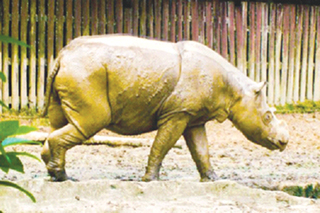Group: Sumatran rhino genome fully sequenced
Published on: Thursday, August 11, 2016

Kota Kinabalu: Just days after University College Sabah Foundation announced that it wants to sequence the genome of the Sumatran rhinoceros, a group of scientists claimed it has already completed the task on Tam, one of the last remaining three rhinos in captivity in Sabah. Genome sequencing is said to be able to allow cloning of the near extinct beast. Scientists and wildlife managers from the Sabah Wildlife Department, Swedish Museum of Natural History and Danau Girang Field Centre on Wednesday said it has successfully sequenced the complete genome of the Sumatran rhinoceros, using the blood samples of Tam.
ADVERTISEMENT
Swedish Museum of Natural History and leader of the project, Dr Love Dalén, said in a statement said that the genome sequencing was made out due to the lack of success in captive breeding programmes and maintaining the animals, as well as producing offspring. "The most pressing reason for obtaining the whole genome sequence of the Sumatran rhinoceros was to identify candidate genes for iron overload disease and reproductive tract pathology which have been the main causes of death in captivity," said Dr Love, who is a professor of Evolutionary Genetics. "Identification of candidate genes and mutations would enable comparisons to human counterpart diseases, thereby leading to a better understanding of the causes and consequences of these diseases in rhinoceroses. "We can then directly apply this information to captive breeding programmes and rhino management with the hope of saving this species from extinction.
ADVERTISEMENT
"I can confirm that the whole genome of the Sumatran rhinoceros has been successfully sequenced and is available for anyone who will need it, as soon as it will be published," she said. Meanwhile, Sabah Wildlife Department Assistant Director Dr Sen Nathan said the success will not lead to any immediate cloning of the rhinoceros as genome sequence is not required for this.
ADVERTISEMENT
"Other technologies that would 'save' the Sumatran rhinoceros from extinction are at theoretical stage and there are several reasons why these technologies may not work at all. "Using cloning or genome editing is not a substitute for the current captive breeding efforts and advanced reproductive techniques being valiantly carried out by BORA and Sabah Wildlife Department on our three captive rhinos," he pointed out. Their comments came following USCF Vice Chancellor Prof. Datuk Dr Ghazally Ismail's statements on Aug 6 that UCSF would pursue genome sequencing of the rhinos as its first step towards cloning the species in collaboration with the University of Salford (UK) and the University of Verona (Italy), adding that the work required approximately RM2 to RM3 million.Towards this end, Danau Girang Field Centre Director Dr Benoit Goosens said the whole genome sequence would be available for free, adding, however, the real cost of a de novo genome assembly of a rhinoceros was much lesser. Stay up-to-date by following Daily Express’s Telegram channel.
Daily Express Malaysia




